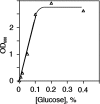Escherichia coli physiology in Luria-Bertani broth
- PMID: 17905994
- PMCID: PMC2168924
- DOI: 10.1128/JB.01368-07
Escherichia coli physiology in Luria-Bertani broth
Abstract
Luria-Bertani broth supports Escherichia coli growth to an optical density at 600 nm (OD(600)) of 7. Surprisingly, however, steady-state growth ceases at an OD(600) of 0.3, when the growth rate slows down and cell mass decreases. Growth stops for lack of a utilizable carbon source. The carbon sources for E. coli in Luria-Bertani broth are catabolizable amino acids, not sugars.
Figures



References
-
- Bachmann, B. J. 1996. Derivations and genotypes of some mutant derivatives of Escherichia coli K-12, p. 2460-2488. In F. C. Neidhardt, R. Curtiss III, J. L. Ingraham, E. C. C. Lin, K. B. Low, B. Magasanik, W. S. Reznikoff, M. Riley, M. Schaechter, and H. E. Umbarger (ed.), Escherichia coli and Salmonella: cellular and molecular biology. ASM Press, Washington, D.C.
-
- Blattner, F. R., G. I. Plunkett, C. A. Bloch, N. T. Perna, V. Burland, M. Riley, J. Collado-Vides, J. D. Glasner, C. K. Rode, G. F. Mayhew, J. Gregor, N. W. Davis, H. A. Kirkpatrick, M. A. Goeden, D. J. Rose, B. Mau, and Y. Shao. 1997. The complete genome sequence of Escherichia coli K-12. Science 277:1453-1474. - PubMed
-
- Fishov, I., A. Zaritsky, and N. B. Grover. 1995. On microbial states of growth. Mol. Microbiol. 15:789-794. - PubMed
-
- Lange, R., and R. Hengge-Aronis. 1994. The cellular concentration of the σS subunit of RNA polymerase in Escherichia coli is controlled at the levels of transcription, translation, and protein stability. Genes Dev. 8:1600-1612. - PubMed
MeSH terms
Substances
LinkOut - more resources
Full Text Sources
Other Literature Sources

